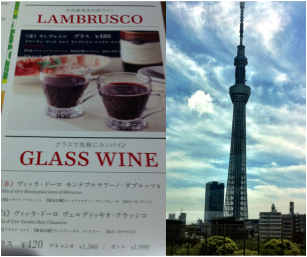 The first "wine list" we saw, and the Tokyo Sky Tree
The first "wine list" we saw, and the Tokyo Sky Tree 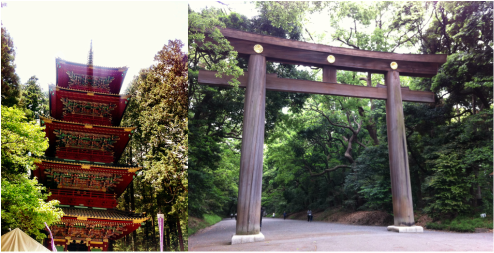 5 Storey Pagoda at Nikko; Gate at Meiji Shrine, Tokyo
5 Storey Pagoda at Nikko; Gate at Meiji Shrine, Tokyo Our travels took us from Tokyo's bustling Megopolis to Nikko, a world heritage site dating back around 400 years. On from there to Hakone, a very quiet and scenic countryside area where we stayed in a luxurious ryōkan, to experience the onsen (hot spring baths) and the fine dining culture of multi-course meals with many separate dishes even within one course. We then hit Osaka, home of the Japanese comedy scene (which of course we didn't see), and Okonomiyaki - a kind of Japanese street food, pancake style. We certainly came back to reality here after 2 such luxurious days.
 Central Tokyo; me in full yukata ready for onsen bathing; scenery around Hakone; "floating" shrine on Miyajima
Central Tokyo; me in full yukata ready for onsen bathing; scenery around Hakone; "floating" shrine on Miyajima  Cherry blossom; Rose flavour; Japanese Caramel from a Japanese Island grown sugar (from a restaurant); enjoying Black Sesame flavour in Miyajima, not enjoying Green Tea and Sakura flavour in Kyoto
Cherry blossom; Rose flavour; Japanese Caramel from a Japanese Island grown sugar (from a restaurant); enjoying Black Sesame flavour in Miyajima, not enjoying Green Tea and Sakura flavour in Kyoto I was so successful with the floral flavours that I got braver. I wish I had stuck to flowers and tried hydrangea, but I couldn't resist trying Black Sesame, if only to experience such a weird looking icecream. It was certainly sesame flavour, and perhaps a bit more savoury than most ice cream lovers would enjoy, but I found it refreshing after a long mountain hike, and as our ferry and train connection back to Hiroshima was the only bit of travel where we suffered a delay, it served to stave off the need for dinner! Finally, I wanted to come back to the cherry blossom flavour, but I felt I owed it to myself to try a new flavour, so I went for a compromise of cherry blossom and green tea (matcha). Japanese green tea is rather odd - it's not at all like what I'd experienced in Hong Kong. It's more or less a powder which dissolves in water, so while it's handy that there are no leaves, it is almost like pea green soup in colour, and some of the ones we sampled had a real seaweed tang. I found the roasted kind slightly more bearable, but I really wasn't a fan. If I was to develop a taste for it, I thought ice cream would be the way to go. But sadly, it just served to ruin my sakura flavour. A sad end to my ice cream experiences!
However, it did lead to a rather nice customer service moment. I'd walked down a thronging tourist trap street with my ice cream and it was melting fast. I was literally covered in a pink and green sticky mess without so much as a napkin. Another ice cream seller (not connected to the one I'd bought from) rushed out from her shop with some wet towels to allow me to wash myself down, and then disposed of my rubbish for me. All without me spending one yen with her. Now that is the kind, friendly and attentive service which we loved in Japan. For those of us who grew up watching Tenko, it's hard to reconcile just how warm Japanese people can be. It is true to say that we often felt invisible, but when it comes to customer service, I had no complaints at all. And coming from me, that's pretty remarkable!
 An insight into the local favourites; the chicken wing; Gingko nuts; me being forced to down dessert in one; used skewers at the end of the night showing how much we enjoyed it!
An insight into the local favourites; the chicken wing; Gingko nuts; me being forced to down dessert in one; used skewers at the end of the night showing how much we enjoyed it! The restaurant itself was very simple but the range of things we tried that night was incredible and almost all met with our approval, though the Konjaku with Roe was hideous despite it's top 10 position. The staff confirmed it's not one that foreigners appreciate, AFTER we'd tried it. I became the centre of attention, with the staff stopping work to photograph me downing in one, accompanied by extreme chanting, their one dessert skewer (actually more of a slider of grilled sweet potato topped with a small ball of vanilla ice cream). The restaurant was called Teppanjinjya, but I don't have the address, so if you can't find it, pop into Captain Kangaroo and ask them for the Teppan place near Dojima and hopefully they can point you in the right direction to experience grilled Gingko nuts, beef neck, ginger, Japanese green peppers, mountain yam and many more which we didn't try, such as chicken gizzard...
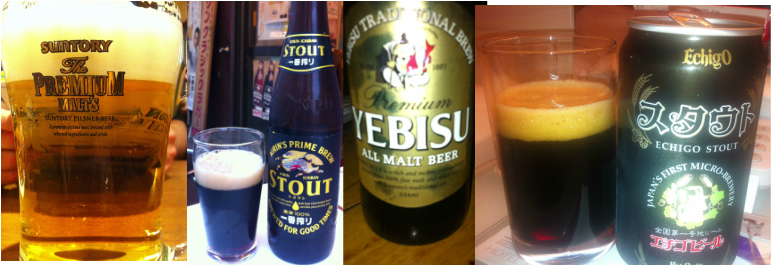
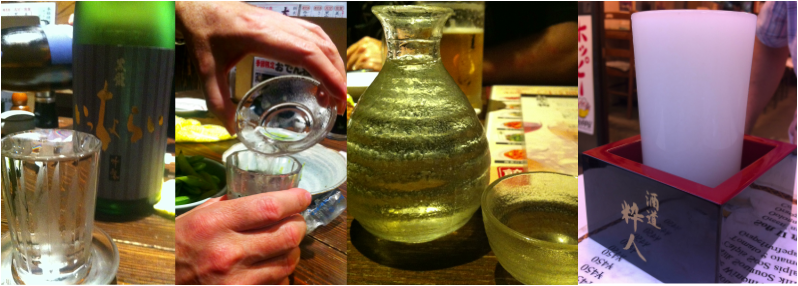 My first sake (sweet style); pouring it from the saucer; another dry sake, this time served in a bowl: Nigorizake (cloudy, unfiltered) served to brimming in a little box.
My first sake (sweet style); pouring it from the saucer; another dry sake, this time served in a bowl: Nigorizake (cloudy, unfiltered) served to brimming in a little box. The most unusual one we sampled was Nigorizake which was kindly bought for us by a complete stranger. This is a cloudy type drink, which looks like milk but is essentially unfiltered saké, a bit like wine with the lees stirred through and not filtered. Technically and legally, this can't really be called saké in Japan. Seishu (清酒), "clear/clean sake", is the Japanese legal definition of sake and refers to sake in which the solids have been strained out, leaving clear liquid. Saké can also be dry or sweet, and though this information can be found on the label, I had no idea how to read it. Most of those I tried were dry although I'm not sure whether sweet really refers to noticable sugar on the palate, or whether this simply refers to the degree of smoothness and body. Certainly that varied. I found the flavours to be quite hard to name, but primarily herbal aromas and they reminded me of a Scottish sweet favoured by Sunday School teachers, OddFellows! Or maybe that's just me.
 My first sample of Shochu (free); the kind (blind?) gent who offered us cloudy sake for my beauty; enjoying homemade Umeshu at the Izekaya Kuroganeya in Asakusa along with it's maker; mass produced Umeshu in Hiroshima
My first sample of Shochu (free); the kind (blind?) gent who offered us cloudy sake for my beauty; enjoying homemade Umeshu at the Izekaya Kuroganeya in Asakusa along with it's maker; mass produced Umeshu in Hiroshima I also tried Umeshu, another Japanese product erroneously known as wine, in this case, Plum Wine. Umeshu is actually more similar to what Brits would recognise as Sloe Gin, given that it's essentially a liqueur based on adding Japanese yellow plums and sugar to shochu raw spirit. This is diluted down to around 15% and I drunk it as recommended, on the rocks. My first experience of this was in the bar where the kind gent had bought us cloudy saké. I felt bold after a few drinks and so went for it. Little did I know it was actually home made! Luckily, I lived to tell the tale and enjoyed it, despite the hint of almond flavour. It did seem to me ironic that we often describe red wine as having plum flavours and this alcohol produced with plum had virtually no recognisable plum flavour at all!
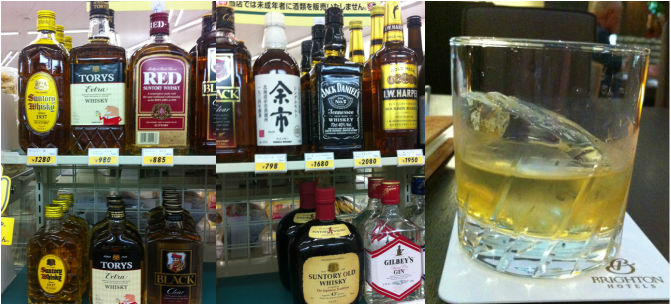 A small selection of the Japanese and other whiskies on offer at the 7-11 and the Yamizake 12 year old single malt
A small selection of the Japanese and other whiskies on offer at the 7-11 and the Yamizake 12 year old single malt Quite how they are getting away with calling it "whisky" (without the e - a spelling normally reserved for Scotch) I don't know, but I saw plenty of bottles labelled this way, so it clearly wasn't a one off mistake. I took the opportunity of a hotel "happy hour" to sample the Yamizake 12 year old single malt, served containing the world's largest "single ice cube". It was smooth and somewhat reminscent of a Speyside style but with a bit more smoke. I had expected to be horrified, but sadly for the Scotch industry, the Japanese do seem to have developed some skill in the production of our national drink. On the other hand, true Scotch was still widely available, and with virtually no price differential, I think there is still a market for Scotland's finest.
Back to Wine of the Week next week. Thanks for reading! Kampei!


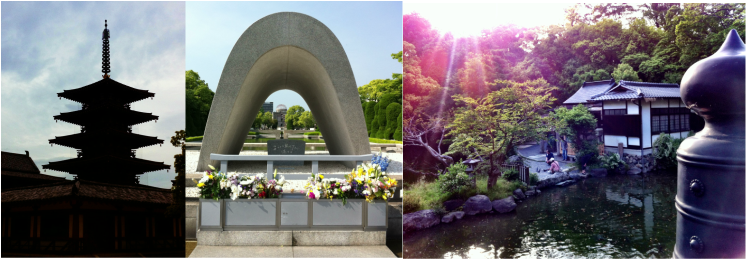
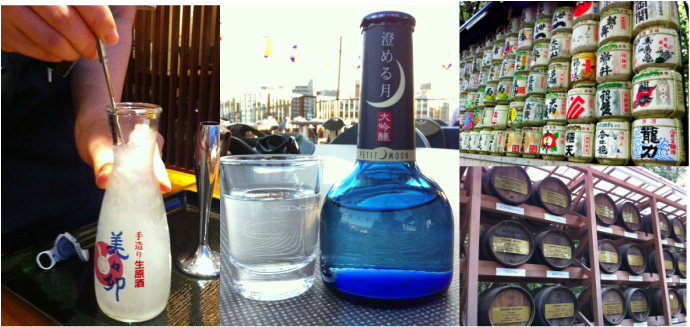




 RSS Feed
RSS Feed
